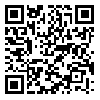BibTeX | RIS | EndNote | Medlars | ProCite | Reference Manager | RefWorks
Send citation to:
URL: http://rjms.iums.ac.ir/article-1-3371-en.html
Background: Nowadays, unstable shoes have been developed in motor activities among people. The purpose of this study was to test the effect of unstable shoes on lower extremity joints power during stance phase of running.
Methods: In this semi experimental study, 30 subjects (age of 21±2.27 years, mass of 72.3±8.84 kg, height of 176.9±5.39 cm) ran in barefoot, unstable and control shoe conditions. Kinematic and kinetic variables were recorded with video camera and force plate. Joint power was calculated via dot product of the joint’s moment and angular velocity of the joint. A 2 way repeated measure variances performed to test the hypothesis using SPSS software (version 20, p<0.05).
Results: Ankle joint negative power was reduced significantly during unstable shoe running compared to control shoe (p=0.02, 49%) and barefoot conditions (p=0.02, 35%). However there were no significant difference between shoes in hip joint. Negative power in knee joint was increased significantly in running with unstable shoe compared to hip (665%) and ankle joints (242%).
Conclusion: Our findings showed that use of unstable shoes may lead to decrease in controlling capacity of shank muscles and active stability in ankle joint. Unstable shoe with increase of ankle positive power compared to barefoot running, could improve the produced force capacity in quadriceps group muscles.





